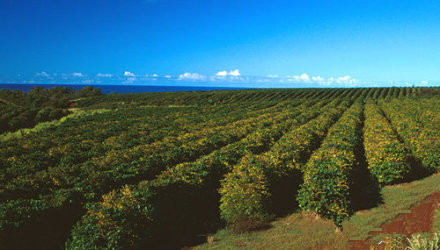Common sense of Coffee Tree planting
After 3 or 4 years of growth, the coffee tree matures and begins to bear fruit, and one fruit will be arranged in clusters or clusters along the branches.

Of course, the coffee beans we see are the seeds of coffee trees. The outside of the seed is a layer of peel, which can be picked as soon as it turns red. Under the red skin (exocarp) there is a layer of pulp (mesocarp), which is a small thin layer, and then a layer of parchment-like substance-endocarp. In all of these peels, there are usually two beans with opposite planes, and the beans have a thin film or skin on the outside.
This kind of berry, as we know it, is a bright red when ripe. Most Arabica coffee beans mature from June to August, while Robbins coffee beans mature from September to October. Therefore, although in some countries where the dry and wet seasons are not obvious, such as Colombia and Kenya, there are two flowering periods a year, that is, two harvests, strictly speaking, only once a year.
As far as picking itself is concerned, there are two ways. One is picking in pieces, that is, picking all the beans after a walk in the garden. The other is selective picking, that is, walking between trees several times at intervals of 8 to 10 days and picking only ripe red berries. Selective picking is more expensive and labor-intensive than picking in pieces, and it is generally only used for Arabica coffee beans, especially those that need to be washed.
The number of coffee beans picked depends on a variety of factors, the most obvious being the height of the trees and the layout of the farm or plantation. The average farm can pick an average of 50 kilograms and 100 kilograms a day. However, only 20% of these weights are real coffee beans, so each picker can only pick 10 to 20 kilograms of coffee beans on average. The coffee beans are packed in a bag with a standard weight of 45kg to 60kg. As a result, it takes three to six days for a worker to fill a bag.
It has been calculated that the cost of harvesting a plantation or farm is half of the total cost of the year. In Brazil, people have tried many times to reduce these costs by mechanical picking. The machine can shake branches across a coffee tree so that berries that become loose because they are fully ripe will fall into the funnel. Mechanical pickers only work in areas with better natural conditions, and they need to be adjusted in advance, because they can only be used where the trees can be planted in rows straight, and afterwards need to check the coffee beans picked by the machine. pick out the leaves and branches that have fallen in the funnel.
Important Notice :
前街咖啡 FrontStreet Coffee has moved to new addredd:
FrontStreet Coffee Address: 315,Donghua East Road,GuangZhou
Tel:020 38364473
- Prev

Basic knowledge of Fine Coffee Classification and Classification of Coffee beans
Coffee beans are graded first by size and then by density. With two exceptions, all coffee beans have a considerable size and the same proportion, with flat on one side and semi-oval on the other. The special cases are pea-shaped coffee beans that tend to be more oval in shape and giant coffee beans with large particles (that is, Marragol peel coffee beans). The prices of these two kinds of coffee beans are always higher.
- Next

What is the basic knowledge of roasting coffee beans?
Roasting skills determine the taste and aroma of coffee, raw beans do not have any flavor, but have a smelly smell. Only after being roasted can it be called coffee. 80% of the taste of coffee depends on baking, so the purpose of roasting is to draw out 100% of the characteristics of coffee, so professional roasters need to know the characteristics of each batch of coffee beans.
Related
- Beginners will see the "Coffee pull flower" guide!
- What is the difference between ice blog purified milk and ordinary milk coffee?
- Why is the Philippines the largest producer of crops in Liberia?
- For coffee extraction, should the fine powder be retained?
- How does extracted espresso fill pressed powder? How much strength does it take to press the powder?
- How to make jasmine cold extract coffee? Is the jasmine + latte good?
- Will this little toy really make the coffee taste better? How does Lily Drip affect coffee extraction?
- Will the action of slapping the filter cup also affect coffee extraction?
- What's the difference between powder-to-water ratio and powder-to-liquid ratio?
- What is the Ethiopian local species? What does it have to do with Heirloom native species?

